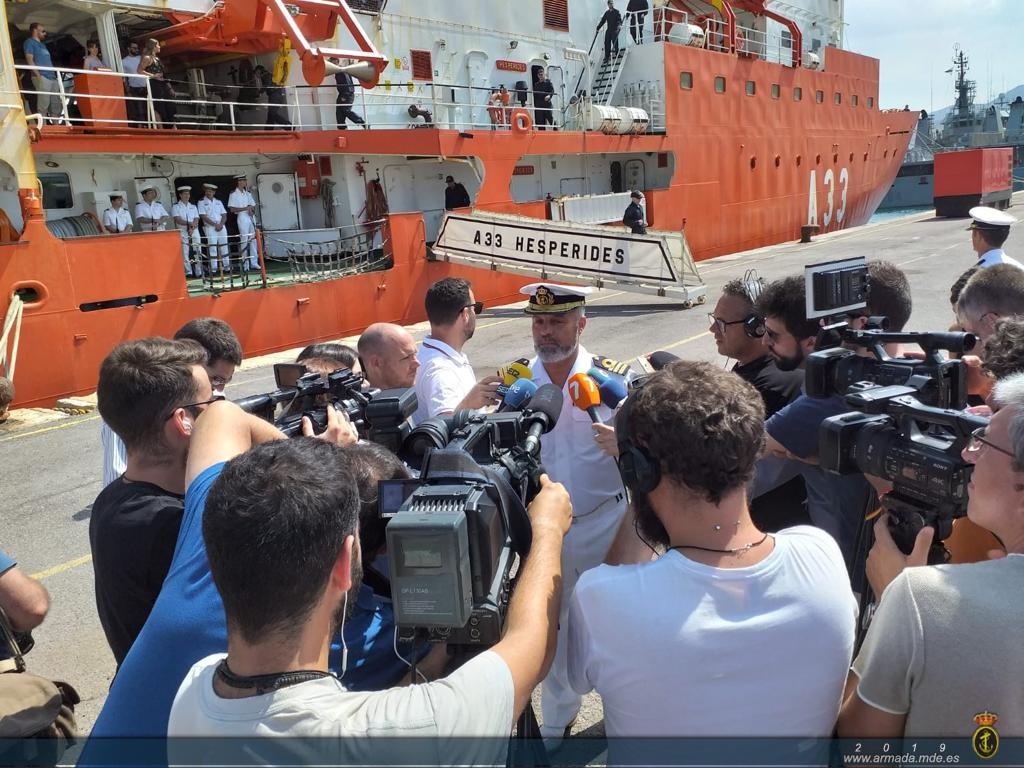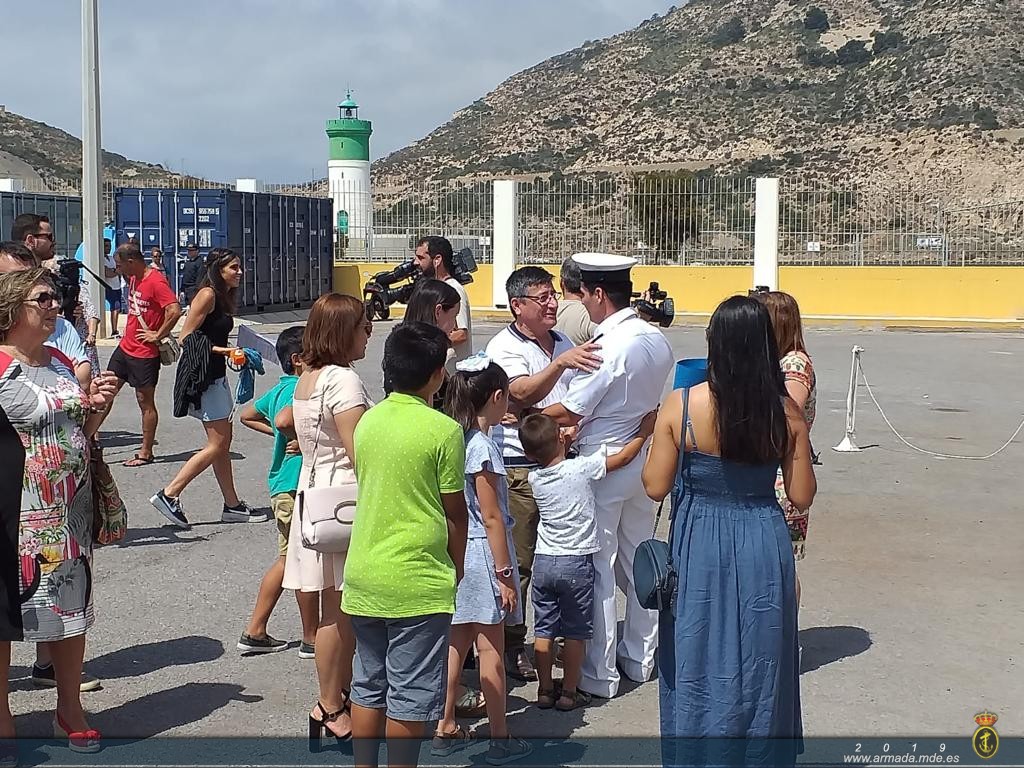The Oceanographic Research Ship ‘Hespérides’ returns to her homeport in Cartagena.
Wednesday, June 26, 2019
The Oceanographic Research Ship ‘Hespérides’ returns to her homeport in Cartagena.
The oceanographic research ship (BIO in its Spanish initials) ‘Hespérides’ arrived yesterday June 25th to the port of Cartagena, thus concluding a deployment that began on December 19th 2018. In this period, the ‘Hespérides’ has traveled more than 30,000 miles and has crossed the Drake Passage that separates the South American continent from the Antarctic Peninsula eight times. This strait is known for its extreme conditions of strong winds and high waves. It has remained nearly two months within Antarctic Treaty waters, south of the 60º parallel, also crossing the Antarctic Circle (66º 33'S), and reaching the southernmost latitude of this campaign in the 68º South.
The 25th Antarctic Campaign of the ’Hespérides’, coincides with the 32nd Spanish Antarctic Campaign. This time, 9 scientific projects of diverse disciplines have been accomplished by 65 people onboard the vessel. In addition, support has been provided to more than 200 scientists and technicians from 12 different nationalities. During this expedition the ‘Hespérides’ has made port calls in Montevideo, Punta Arenas, Ushuaia, Rio de Janeiro, Las Palmas (Canary Islands) and Funchal (Madeira).
On the occasion of the inauguration in February 2019 of the refurbishing and upgrading of the Spanish Antarctic base ‘Juan Carlos I’ by the Minister Pedro Duque Duque, the ‘Hespérides’ received on board a delegation of different authorities from the Ministries of Defense and Science, Innovation and Universities.
Apart from serving as a platform for scientific research, and providing support to research personnel who have developed their projects on land, the ship has collaborated offering logistic support to polar programs of Bulgaria, Colombia, Portugal, United Kingdom and Uruguay. Likewise, BIO ‘Hespérides’ has transferred materiel and personnel from the Spanish bases ‘Juan Carlos I’ and ‘Gabriel de Castilla’ –as well as the Bulgarian Antarctic base ‘St Kliment Ohridski’– to the port of Ushuaia, after having closed those bases before the arrival of the austral winter.
Moreover, continuing with a tradition started in 2014, the ‘Hespérides’ took more than 3 tons of solidarity aid to the Shelter House ‘Miraflores’ in Punta Arenas; a shelter for children between 3 and 10 years in situation of vulnerability, as well as for people over 60 with some degrees of helplessness.
After the Antarctic Campaign was over, the ‘Hesperides’ participated in the ZEEE-2019 campaign in Las Palmas (Canary Islands), in which she carried out hydrographic and oceanographic studies in that Spanish Exclusive Economic Zone (EEZ). The ZEEE-19 campaign was devoted to the study of the waters and sea beds in the north and south of the archipelago, continuing the work started out in this area during the years 1998, 1999, 2000, 2011, 2012, 2017 and 2018. For this task the systems installed on board the ‘Hespérides’ were used, mainly multi-beam probes, gravimetric equipment, magnetometric equipment and geological parametric probes. During this campaign, a systematic survey of a total of 75,000 km2 of the ocean floor was carried out, equivalent to something less than the extension of the entire autonomous Spanish region of Castilla-La Mancha.
More than 60 researchers and scientists from several agencies participated in this campaign, including the Spanish Navy Hydrographic Institute (IHM), the Royal Institute and Observatory (ROA), and various collaborating organizations such as the Spanish Institute of Oceanography (IEO), the Geological and Mining Institute of Spain (IGME), and the ‘Complutense’ University of Madrid (UCM), Cádiz (UCA) and Las Palmas de Gran Canaria (ULPGC).
Commemoration of the 5th Centenary of the first circumnavigation of the world.
On the occasion of the 500 Anniversary of the first circumnavigation of the globe by Ferdinand Magellan and Juan Sebastián de Elcano, the ‘Hespérides’ hoists the commemorative flag as part of the group of ‘5th Centennial Vessels’. This is a group of Spanish Navy units currently in service that have completed a voyage round the world (in this case the ‘Malaspina’ Expedition 2010-2011).
About the Oceanographic Research Ship ‘Hespérides’
The ‘Hespérides’, cataloged as Singular Technical Scientific Infrastructure (ICTS), is the only Spanish oceanographic vessel designed to conduct multidisciplinary scientific research projects in all the seas and oceans of the planet. It has a crew of 55, currently under command of Cdr. José Emilio Regodón Gómez, and has the capacity to accommodate up to 37 scientists and technicians. It has a length of 82.5 meters displacing 2,832 tons at full load. Its range is 12,000 miles at 12 knots, and it can operate up to 60 days without refueling. It has a total of 11 equipped laboratories, distributed in more than 350 m2 dedicated exclusively to research tasks. The vessel was built with a reinforced steel hull and keel to operate in icy waters.
After the implementation of the Polar Code of the IMO (International Maritime Organization), as of January 1st 2018, the ‘Hespérides’ was licensed for operations in polar waters, having been certified as a ‘C’-class vessel.
Spanish Antarctic Campaign
The Spanish Antarctic Campaign is a model of cooperation between different public and private institutions at the service of R+D projects, within the framework of the State Plan for Scientific, Technical Research and Innovation.
The Ministry of Science, Innovation and Universities finances the operation and maintenance of the ‘Hespérides’ and ‘Sarmiento de Gamboa’, as well as the expenses associated with the logistics of the Antarctic campaigns. It also collaborates financing the Spanish Antarctic bases ‘Gabriel de Castilla’ and ‘Juan Carlos I’.
The 32nd Spanish Antarctic Campaign included 24 research projects, 18of which were funded by the State Research Agency, one by the State Meteorological Agency and another by the Spanish Navy Hydrographic Institute. In addition, the Spanish facilities in the Antarctic have also provided support to projects organized by Brazil, Chile, Colombia, Norway, Portugal and the United Kingdom.
Last year marked the 30th Anniversary of Spain's admission to the Antarctic Treaty as an Advisory Member, which has led to its international recognition in Antarctic science and its firm commitment to protecting the continent.




 + 3
+ 3



